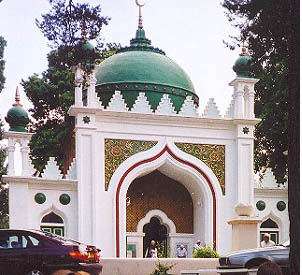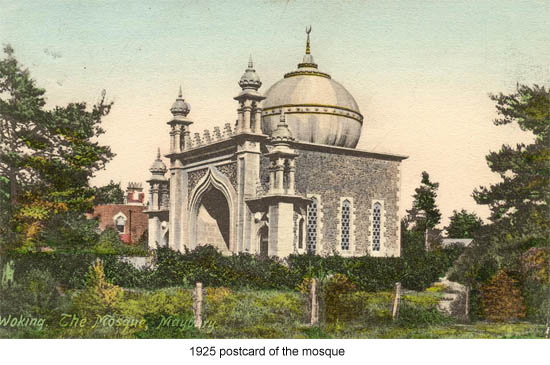The Shah Jehan Mosque
by Syeda Z. Hamdani
 London's Shah Jehan Mosque stands tall and majestic at 149 Oriental Road, Woking, between Railway Homes and the old James Walker building. This mosque has the distinction of existing as the oldest Muslim place of worship in Britain. London's Shah Jehan Mosque stands tall and majestic at 149 Oriental Road, Woking, between Railway Homes and the old James Walker building. This mosque has the distinction of existing as the oldest Muslim place of worship in Britain.
Surprisingly, it was a non-Muslim who commissioned this historical treasure. Dr. Gottlieb Wilhem Leitner, a Hungarian-born scholar, acted as principal of Punjab University, Pakistan. He proved his love of knowledge by gaining fluency in Turkish, Arabic, and most European languages.
To encourage others to gain knowledge, Leitner moved to Woking and founded the Oriental Institute in 1883. Here Asian students could learn skilled professions and Europeans could prepare for lives in the Orient. To supplement the Institute, Leitner hoped to build places of worship for all major faiths, including a mosque, synagogue, church, and temple.
With the ruler of Hyderabad, India, providing financing, Leitner purchased land for the mosque. Several individuals helped with construction costs, but none more so than Begum Shah Jehan, who ruled the kingdom of Bhopal as upon the death of her mother, Sikander Begum. She also built the Taj-ul Masajid at Bhopal, one of India's largest mosques, and contributed to the establishment of the Muhammadan Anglo-Oriental College at Aligarh, which would later become the Aligarh Muslim University. A supporter of Leitner at Punjab University and became the greatest contributor for the mosque's construction, and Leitner named the mosque in her honor.
Leitner chose Victorian architect WL Chambers to design the mosque. After much quarrelling, the two agreed on a sketch based on an Indian mosque. Leitner's project used barth and Bargate stone for its construction. By 1889, the Shah Jehan Mosque was complete and open to the public.
With its domes and arches, the mosque stood out. Leitner made sure to place a fountain just outside the mosque for ablution, the washing before prayers. In addition, he constructed the Sir Salar Jang Memorial House as the residence for the Imam, the Muslim pastor.
Nearby Muslim residents, as well as students at the Institute, came to the Shah Jehan Mosque for prayers and religious holidays. Sadly, the mosque and the Institute both shut down after Leitner's death in 1899. He was unable to construct the other places of worship during his lifetime.
In 1912, Khwajal Kamal-ud-Din, a Muslim lawyer and scholar, revived the mosque. The following year, the Shah Jehan Mosque reopened as a place of worship and as the headquarters for the Woking Muslim Mission, under Kamal-ud-Din's leadership.

The mosque became the center of Islam in Britain. Members of nobility, such as Lord Headley, converted to Islam and another member and convert, Marmaduke Pickthall, published the first English translation of the Quran by a Muslim. The mosque also enjoyed visits from world leaders, such as the Shah of Persia and then-Prince Faisal of Saudia Arabia. In 1965, the Mission ceased to exist and the Mosque's control went to Sunni Muslims.
Today the mosque is still under Sunni control, and has the honor of being listed as a historical Grade 11 building. Since 1995, the local community has renovated the mosque and restored its original beauty. From the outside, the mosque amazes today's visitors with its huge blue-and-gold, crescent-topped dome. A smaller dome stands at each end, with a triangular design between them. Intricate flowers surround the entrance and geometric shapes cover the door.
A mosaic pavement with a fountain leads to the door. Today the fountain only adorns the mosque, since a separate facility exists for ablution. Another new addition to the mosque, the garden, leads visitors to the south entrance. The garden forms a hexagonal shape, with a walkway in the center. Plans are underway to turn the garden into an enclosed sanctuary.
Inside the mosque, verses of the Quran decorate the walls and the mihraab, where the Imam leads prayers. Arabic calligraphy also adorns the ceiling in a circle surrounding the central chandelier. Minarets support and add beauty to the mosque.
The mosque welcomes visitors, young and old, to the historical site and its new facilities. Tourists are asked not to visit on Fridays during prayer time (usually 1-2 p.m.).
More Information:
We regret that we no longer have the resources to maintain up-to-date links and/or hours and pricing details for the various sites and attractions listed on this website. For more information about the location(s) listed above, please use your favorite search engine or visit Wikipedia.
Syeda Hamdani is a freelance writer based in Sacramento. She enjoys spending time with her children and sewing.
Article © 2005 Syeda Z. Hamdani
Photos courtesy of Woking Galleries
| 